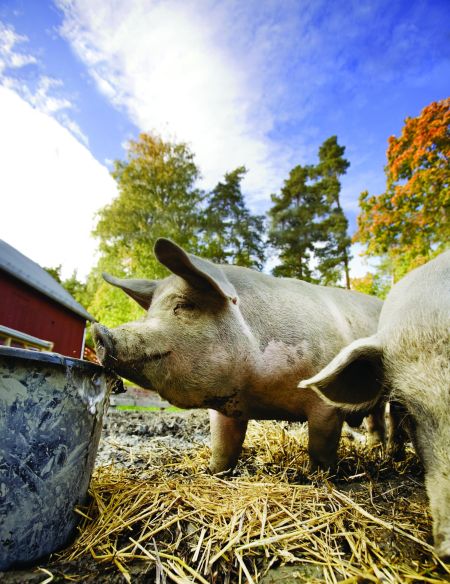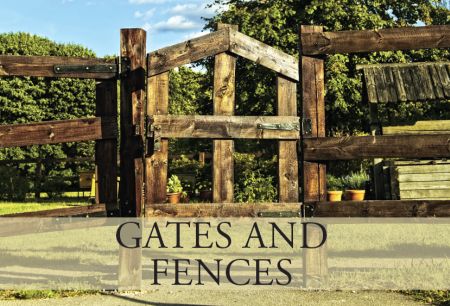
Whether you are looking to add a lovely fence and gate around your garden plants or you have poultry or other livestock to keep in check, you may need to build a fence, gate, or animal pen. These structures can be attractive if well-built and should be able to stand up to all kinds of weather and animals. Depending on your needs, here are some various fences, gates, and pens you can easily construct in your yard or on your property.
Fences
Fences are perfect for keeping animals or young children in a confined space or for drawing boundaries between yours and your neighbor’s property lines—but check with your neighbors before you construct your fence to make sure they don’t mind. Also call your local utility companies to make sure that you will not be digging up power or gas lines.
Wooden Fences
Wooden fences allow for good ventilation and an open, airy feel. They can provide protection for young shrubs and plants as well as keep animals and children safe within the yard or fenced-in space.
The most common type of wooden fence consists of horizontal rails nailed to posts or stakes that are placed vertically into the ground. These fences can be constructed with three or four horizontal rails made out of split wood, spruce, or pine wood planks. The posts are usually about 6 feet long and sharpened at the end that will be driven into the ground (to a depth of roughly 8 inches). These posts should be spaced about 6 feet apart.
To keep the pointed, earth-bound ends from rotting, dip them in melted pitch before inserting them into the ground. To do this, boil linseed oil and stir in pulverized coal until it reaches the consistency of paint. Brush a coat of this on the wooden post. Make sure the posts are completely dry before painting them. If properly done, this should keep moisture from seeping into the buried parts of the posts and will keep your fence upright for many, many years.
To drive the posts into the ground, use a very good shovel or a heavy wooden mallet. For longer poles, use a post-hole borer. This saves lots of time and energy and will work with almost all types of soil.
To construct a basic wooden fence, you’ll need:
Materials
• Post-hole diggers, a post-hole borer, or a shovel
• 4 x 4 wooden posts (wood that has been treated will last longer but is not necessary)
• 2 x 4 lumber (this too can be treated but does not need to be) or fence boards (which can be purchased at your local home and gardening center)
• Thick, long nails
Directions
1. Decide where the fence will be constructed and then lay a line of twine or string to mark out the border.
2. Decide how tall you want your fence to be. Take into consideration what the fence is being used for (if it’s for larger animals, such as llamas, you may want a 6-foot-tall fence; if for decoration, a shorter fence may do the trick).
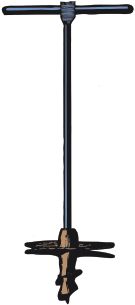
A hole borer lifts the soil from the hole without having to use spades. These borers can be used by hand or electric models can be purchased for the same purpose.
3. Dig holes for your end posts (in all four corners of your fence). Make sure the holes are deep enough to support the end posts. Fill in dirt around the posts and pack in the soil very well.
4. Start digging the remaining holes, keeping them aligned with the end posts.
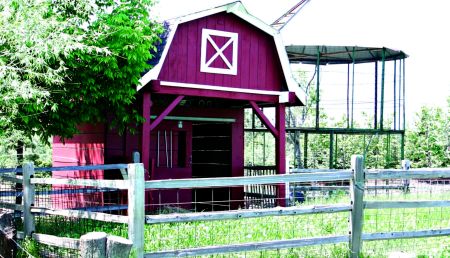

A simple wooden fence is enough to keep most animals in their pastures.
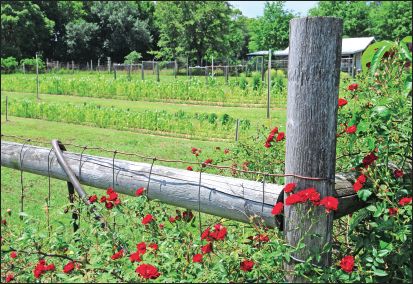
You can nail wire mesh to the rails of a wooden fence for extra security or to allow vines or other climbing plants to grow up along the posts.
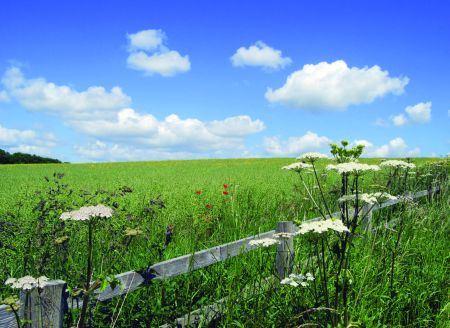
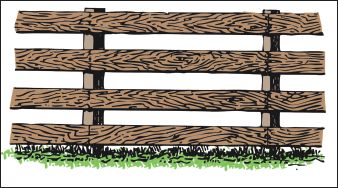
A basic wooden fence.
5. Insert the remaining posts into the holes, piling in the dirt and packing it down as before.
6. Nail on your fence boards, leaving a little space in between. Paint or stain the finished fence if you wish.
Note: If you want a privacy fence, you can nail thicker boards horizontally or vertically between each post, leaving little space in between.
Wire Fences
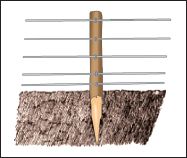
Drive your fence poles far enough into the ground that they stand firmly upright even when moderate pressure is applied to one side.
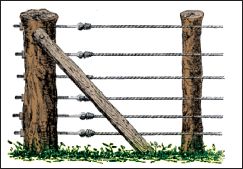
A G-line wire fence consists of three-ply strands of wire.
A picket fence is constructed by nailing two or more long boards to posts, and then nailing narrow vertical boards to the horizontal ones.
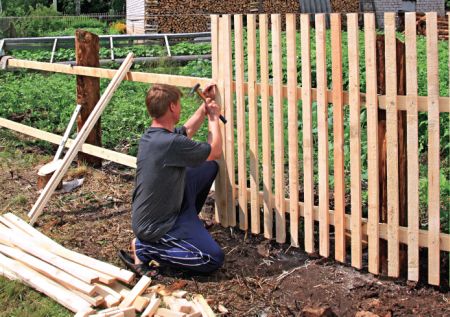
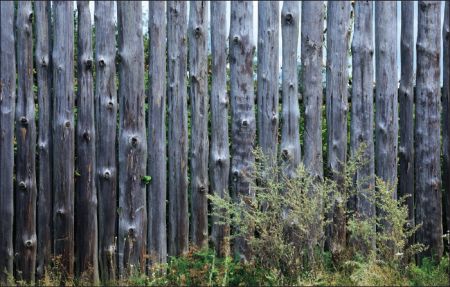
A very simple fence can be made by driving small tree trunks or branches into the ground in a tight row.
Wire fences are both portable and durable, making them convenient and economical to build. Wire fences usually have a longer staying power than wooden fences since they are less prone to deterioration or rot.
The most common type of wire fence is one that has wire lines strung between wooden posts. The wires are fastened to the posts by galvanized wire staples. The wooden posts should be spaced roughly 6 feet apart and should use five single wires.
A more substantial wire fence can be made with G-line wires. Each line consists of a three-ply strand. Instead of the wires being fastened to the post by staples, holes are bored through the posts and the lines pass through. Straining eye bolts with nuts and washers are attached for tightening up the fence. This type of fence, however, is much more expensive to build and, unless you desire a fence that is incredibly strong, is probably not necessary.
Wire Netting Fence
Galvanized wire netting fences are used for enclosing root gardens and for poultry fences. The standard type of netting used when making this fence is 3-inch mesh netting that is 3 feet x 3 feet, and is rather inexpensive to buy.
A separate strip of 2-inch galvanized wire netting that is 6 inches wide can be laid flat on the ground on the side of the fence where the poultry are—this way they can not dig underneath, especially once grass and other natural materials hide the wire netting.
A wire netting fence.
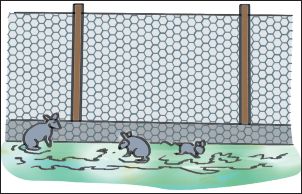
To dig in this type of fence, make a trench about 6 inches deep; drop the netting into it; and then fill the trench up with dirt, stones, or even concrete, depending on how permanent you want the fence to be.
Portable Fences
If you need a temporary fence or if you want to easily move your livestock fence to new grazing areas on your property, you may want to consider one of these easily made, movable fences. Below are a few types of portable fences that can be tailored to your specific needs.
Convenient and Portable Fence
Often it is helpful to have a fence that can be quickly erected and disassembled. This fence is very cheap, strong, and convenient to use. It is built out of pine (any other wood can be substituted, but pine is typically lighter and easier to move), 1 x 6 inches for the bottom rail and 1 x 4 inches for the top rails. The braces that hold it upright are 2 x 4 inches and the base (cross piece) is 2 x 6 inches. The base is notched 2 inches and the bottom boards are notched with holes.
The base piece, which is more susceptible to rot, could be made out of a stronger wood, such as oak. Make sure the panels aren’t too long or they might warp out of shape. This fence can be put up very quickly and taken down again with ease if you want to move it to another part of your yard or get rid of it for a while.
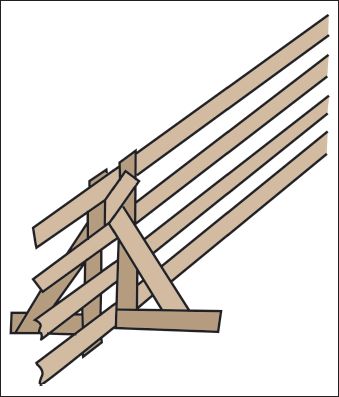
A portable fence.
Scotch Hurdle Fence
This movable fence consists of two posts, each 2 x 3 inches and 4½ feet long. The lower ends are long and pointed which allows them to easily enter the ground and prop up the fence. The brace and two diagonals are made of larch or fir wood. This fence is around 9 feet long and 4 feet high.
The Scotch hurdle fence is easy to set up. The incline should be facing away from any livestock you might have contained inside of it. A stay should be placed between every two hurdles to keep them in position. One wooden peg should be fastened to one end of the hurdle and another peg driven through the other end and into the ground.
This Scotch hurdle fence is good for temporary use. If you live in a very windy area, however, this fence may not suit you well, as they do have a tendency to fall over in strong gales.

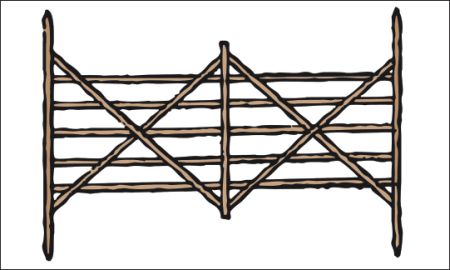
An English hurdle portable fence.
English Hurdle Portable Fence
This movable fence is much lighter, cheaper, and more convenient than the Scotch hurdle fence. Usually made of split oak, this fence is tough and impenetrable. It consists of two upright end pieces that are joined by four or five mortised bars 7 to 9 feet long. These are strengthened by an upright bar in the middle and two or more diagonals. The end pieces are long and pointed for setting into the ground. To set these into the earth, use an iron crowbar to avoid splitting the top of the wooden piece.
These fences are set erect and no stay is needed. The two adjoining ends of the fences are connected with a band that is passed over them.
Gates
Gates are a necessary part of any fence or pen and they can be situated in the fence wherever they can be easily accessed. If you have a field, your gate should be roughly 10 feet wide to allow small machinery through.
Most gates are made of either wood or iron (though iron is obviously much more expensive and more complicated to work with). Wooden gates will suffice for most of your homesteading needs. The following are a few simple gates that can be used for your garden, your backyard fences, and your pens housing livestock.
Inexpensive, Simple Gate
A light, useful, and durable gate can be made of sassafras poles (or other tall grass poles) and wire. Dig and place a strong post 4 feet in the ground in the middle of the gateway and balance the gate on it. The lower rail is made of two forked sassafras poles securely nailed together so they can be coiled back over the post.
Easily Opened Gate
To construct this simple gate, take an old wheel (possibly found at an antique store or rummage sale) and fasten it to make a gate that you will be opening frequently. The piece of board (A) drops between the spokes of the wheel and holds the gate either open or closed.
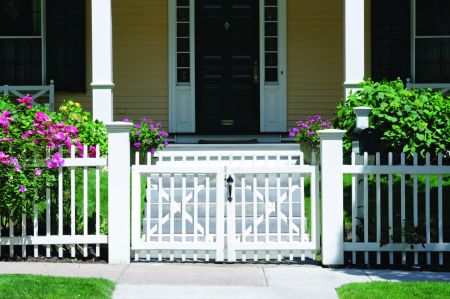
Gates can be useful for entrances to a yard or walkway, as well as for animal pens or pastures.
A basic wire gate can be constructed when you need an opening in your fence.
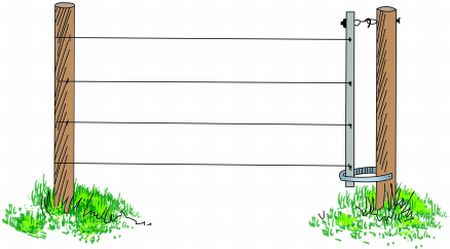
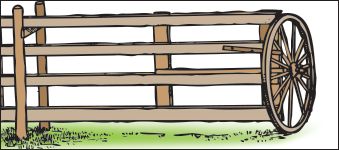
An easily opened gate.
Rustic Garden Gate
If your garden is bordered with a fence, or if you have shrubs or hedges enclosing your backyard, you will want to install a homemade gate through which to enter the garden or yard.
This gate plan is made 6 feet square and 8 feet tall. Any type of timber can be used. To construct the gate:
1. Cut the closing and hinging sides 6 feet long, 6 inches wide, and 2½ inches thick. The three rails are of the same dimensions and can be halved to the stiles or wedged and braced.
2. Separate pieces are fixed on the center to support the gate and to make the frame, on which the boards will be attached.
3. Two gate hinges and hooks can be bolted on or secured from the back with square-headed coach screws.
This rustic garden gate blends in well with natural surroundings.
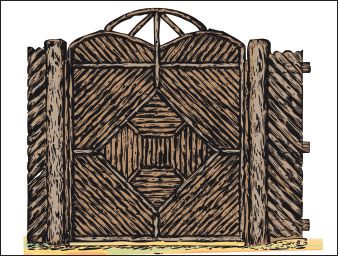
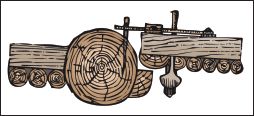
Closing stile for a garden gate.
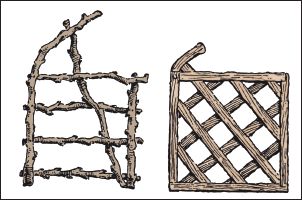
Either of these gates will work well with the rustic garden
gate.
4. Begin fixing the debarked twigs—they should be as straight as possible.
5. To make the joint ends, start by fixing the outside square then the two inner squares and finally the diagonal filling.
6. The posts should be 9 inches in diameter by 9 feet long (3 feet should be buried underground). Cut three mortises in the posts to insert the rails for the side fencing. These rails are nailed flush to the secondary posts.
7. Dig holes for the posts and pack in the soil tightly (or fill in the holes with cement for a permanent fixture).
8. After a week or so (let the cement dry fully), the gate can be hung on the hinges and the latch positioned correctly.
Simple Gate
This is a simple and appealing gate, especially for fences leading into pastures. The materials required to make this gate vary depending on what purpose the gate will serve.
For a paddock or pasture gate, make it out of seasoned boards, 1 x 6 inches and 12 to 14 feet long. The posts supporting the gate should be placed about 5 inches apart, the one on the inside being about 8 inches ahead of the other. These are joined together by cleats or rollers that support the gate and allow it to be pushed back and swing open. if rollers are not obtainable, cleats made of any hard wood are acceptable.
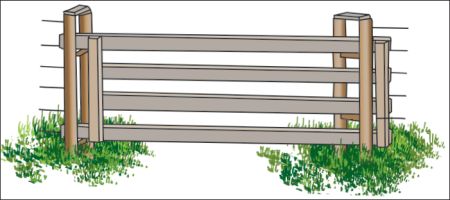
A simple sliding gate can be made for any modern or wire fence.
A bamboo fence or gate can be constructed by lashing the bamboo together with strong rope.
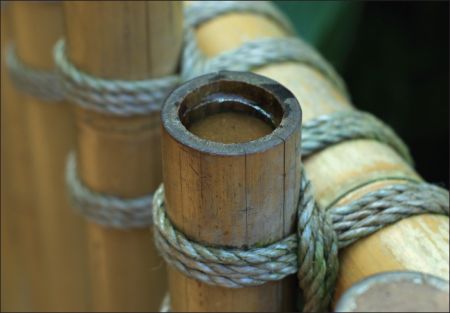
Pens
If you have built a simple stable to house your llamas, sheep, or other animals, it will be beneficial to build a small fence around it as an outdoor pen. A basic wooden fence or a simple wire fence will enclose most of your livestock in an area around the stable or shelter. If you have a llama or two, it is best to have at least a 4-foot fence so they cannot escape. If you have ample space, having a pathway into a larger grazing field or pasture from your pen will allow your animals to come and go as they please. Or, if you want to keep them confined in the pen, a simple gate will suffice for when the animals need to be removed or relocated.
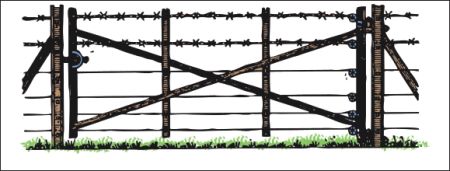
This wire gate is hung on ordinary iron posts. The heel of the gate, made of angle iron, is fitted with winding brackets for tightening the wire bars.
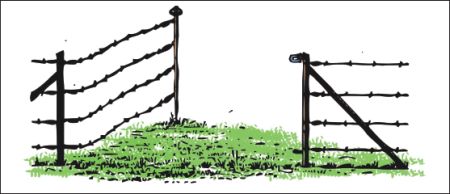
A simple wire swinging gate.
